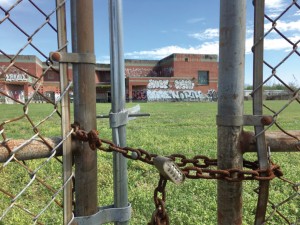OPSB must pay $12M to students who attended school atop hazardous waste site
12th March 2018 · 0 Comments
By Marta Jewson
The Lens
A civil district court judge has ordered the Orleans Parish School Board to pay about $12 million to 1,433 former students who attended a school built on a hazardous landfill decades ago.
That equates to $1,000 for every year each student attended Robert R. Moton Elementary School atop the Agriculture Street landfill in the Desire neighborhood. The city and the Housing Authority of New Orleans faced similar lawsuits related to public housing nearby.
Plaintiffs argued the city and the school board did not ensure the area was safe before building homes and the school on contaminated sites.

Moton Elementary School on Abundance Street seen through the fence that surrounds its yard. The U.S. Environmental Protection Agency declared the school and area around it a Superfund Site in 1994.
The school district actually delayed its groundbreaking in 1985 to replace topsoil, but a decade later, tests showed toxins throughout the neighborhood.
“This money is for children. It’s not a lot of money. It’s not going to make them rich,“ said Joseph Bruno Sr., attorney for the plaintiffs.
But the state constitution makes it hard to enforce judgments against government agencies.
“I have what is called a paper judgment,” Bruno said. “And I have to wait for the good graces of the school board.”
Another group of plaintiffs won their case against the city, and the judgment is on the city’s list, a city spokesman said.
In the suit against the school district, a judge ordered it to pay $1,000 for each year a student attended, plus interest. Individual awards range from about $2,000 to more than $20,000. The school served kindergarten through sixth grade.
A school district spokeswoman said it would follow state law governing the judgment.
It doesn’t appear the school board will pay the judgment this school year. That’s up to Superintendent Henderson Lewis Jr., and in September, the board approved his recommendation not to pay legal settlements or judgments because of a tight budget.
Bruno said he hopes the district will pay the judgment given its recently improved credit rating and declining operating deficits.
“This is not a particularly large obligation,” he said.
School Sits Empty
Opened in 1987, the old Moton building is newer than several facilities still in use. Moton converted to a charter school after Hurricane Katrina and operates at a different campus in eastern New Orleans.
Today, the abandoned school’s windows and doors are sealed, and a locked chain-link fence wraps around the yard.
Across the street from the graffiti-covered elementary is a mix of decrepit houses and well-kept homes with freshly cut grass and Saints flags.
In their lawsuit, Bruno’s clients alleged the district knew the site was polluted before they built the school.
The Agriculture Street Landfill was used from 1909 to 1957. It reopened for a year
The Environmental Protection Agency tested the soil in 1993. In 1994, it declared the area a Superfund site, meaning it was so contaminated that it should be remediated to protect people and the environment.
The district closed Moton Elementary and used space in a Catholic school for seven years.
The federal agency removed topsoil in various parts of the neighborhood and replaced it with clean dirt, which was cheaper than a buyout.
But the EPA decided Moton did not need new topsoil, according to a Times-Picayune story on the cleanup, because it had been constructed on five feet of fresh soil.
The EPA removed Moton from the Superfund list in 2000 and the district reopened the school the next year.
But it closed again after Hurricane Katrina.
Schools On Dumps
This wasn’t the first time the district built a school atop an old dump, nor was it the last.
Booker T. Washington High School, the city’s first technical high school for African Americans, was built on what once was the Silver City Dump on Earhart Boulevard next to the B.W. Cooper public housing complex.
The high school was closed after Hurricane Katrina. The district and state-run Recovery School District decided to rebuild at the same site.
They planned to reopen Booker T. Washington and merge it with Walter L. Cohen High School. When alumni learned that toxins were still found on the site, they argued against any school being built there.
But the Recovery School District had a plan to remediate the site. The plan involved removing topsoil, installing a barrier and grading the site with clean soil.
A unique, three-way swap ensured Cohen could stay at its Uptown site. KIPP New Orleans decided to open a new high school at the Booker T. Washington location.
Construction is underway. KIPP New Orleans has already started Booker T. Washington High School at another site, and it will move to the new facility.
In 2015, a bill to ban building schools on former dump sites failed in the state Legislature.
The above article originally appeared on The Lens website (www.thelensnola.org). The Louisiana Weekly enjoys a partnership with The Lens.
This article originally published in the March 12, 2018 print edition of The Louisiana Weekly newspaper.



